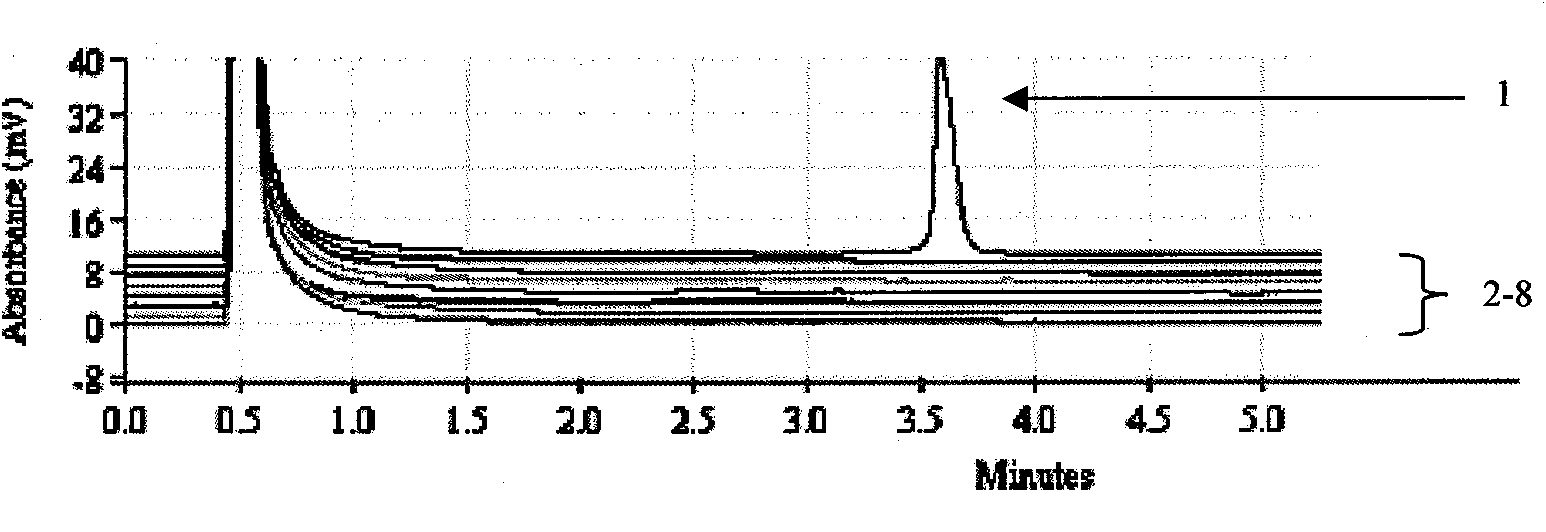Detection kit and detection method for 5 new pathogens in foods
A technology for detection kits and detection methods, applied in the directions of microorganism-based methods, biochemical equipment and methods, and microbial determination/inspection, etc., can solve the problems of small target bacteria range, delayed diagnosis and treatment, complicated operation, etc. The effect of short detection time, labor and financial saving, and simple operation
- Summary
- Abstract
- Description
- Claims
- Application Information
AI Technical Summary
Problems solved by technology
Method used
Image
Examples
Embodiment 1
[0050] Embodiment 1, the establishment of the detection kit and detection method of 5 kinds of emerging pathogenic bacteria in food
[0051] (1) The design, synthesis and kit assembly of primers, as described in Table 1:
[0052] Table 1
[0053]
[0054]
[0055] On this basis, design kits for PCR-DHPLC detection:
[0056] The kit includes 5 kinds of detection solutions, respectively for the detection of Hong Kong gull-shaped bacteria, Serratia marcescens, Serratia odorifera, P. A, B, C, D, E, where:
[0057] Detection solution A contains 10mM Tris Cl, 50mM KCl, 25mM MgCl 2 , dNTP (dATP, dGTP, dCTP and dTTP) 2.5mM each, Taq DNA polymerase 5000U (5U / μL) and the Hong Kong Gull-type bacteria primer pair 10μM described in Table 1;
[0058] Detection solution B contains 10mM Tris Cl, 50mM KCl, 25mM MgCl 2 , dNTP (dATP, dGTP, dCTP and dTTP) each 2.5mM, Taq DNA polymerase 5000U (5U / μL) and Serratia marcescens primer pair 10μM described in Table 1;
[0059] Detection solu...
Embodiment 2
[0085] Embodiment 2, detection method specificity test
[0086] According to the analysis conditions established in Example 1, PCR-DHPLC specificity tests were carried out on 35 kinds of microorganisms respectively.
[0087] (1) Specificity test results of Vibrio mesoni
[0088] Select 28 strains of related species and 24 strains of non-related species of Vibrio meerioi, and perform PCR-DHPLC detection according to the method and conditions established in Example 1.
[0089] The selected related species strains include: Vibrio parahaemolyticus, Vibrio cholerae O1 group, Vibrio cholerae O139 group, Vibrio vulnificus, Vibrio alginolyticus, Vibrio mimicus, Vibrio riverine, Vibrio proteolyticus, Vibrio cholerae A total of 28 standard strains and isolates of Aeromonas water, P. shigella-like strains and other strains.
[0090] Selected non-related strains include: Listeria monocytogenes, Pseudomonas aeruginosa, Enterobacter sakazakii, Escherichia coli, enterohaemorrhagic Escheric...
Embodiment 3
[0109] Embodiment 3, detection sensitivity test
[0110] (1) Sensitivity test for detection of Vibrio meeseri
[0111] The standard strain of Vibrio meeriii was cultured at 36°C for 24 hours, and the sensitivity test method using the plate counting method was used as a comparison to extract and prepare template DNA for each dilution gradient for PCR-DHPLC detection. The results are shown in Table 2. Positive absorption peaks were detected for Vibrio meerii with a count of 7600CFU / mL, 790CFU / mL and 76CFU / mL, but no positive absorption peak was detected at a concentration of 5CFU / mL. The test results show that the method established in this study can detect 10 of the standard strains of -6 The concentration gradient, that is, the detection sensitivity can reach 76CFU / mL.
[0112] Table 2
[0113]
[0114] a: The dilution factor between the 7 gradients is 10 times;
[0115] b: The plate count result is the average of two parallel plate count results.
[0116] (2) Serratia...
PUM
 Login to View More
Login to View More Abstract
Description
Claims
Application Information
 Login to View More
Login to View More - R&D
- Intellectual Property
- Life Sciences
- Materials
- Tech Scout
- Unparalleled Data Quality
- Higher Quality Content
- 60% Fewer Hallucinations
Browse by: Latest US Patents, China's latest patents, Technical Efficacy Thesaurus, Application Domain, Technology Topic, Popular Technical Reports.
© 2025 PatSnap. All rights reserved.Legal|Privacy policy|Modern Slavery Act Transparency Statement|Sitemap|About US| Contact US: help@patsnap.com



